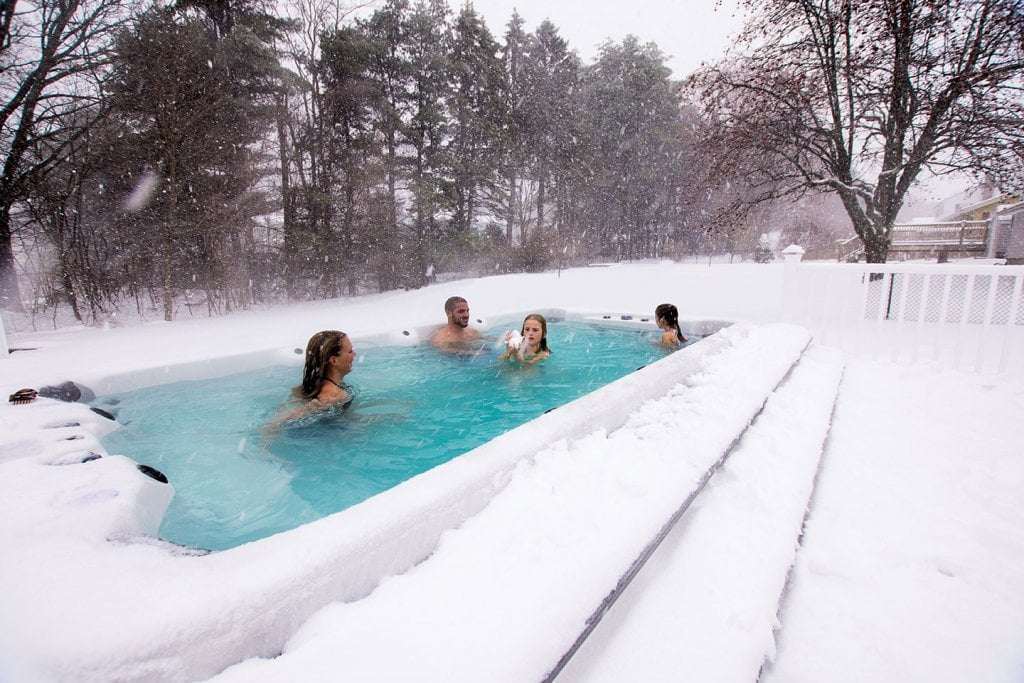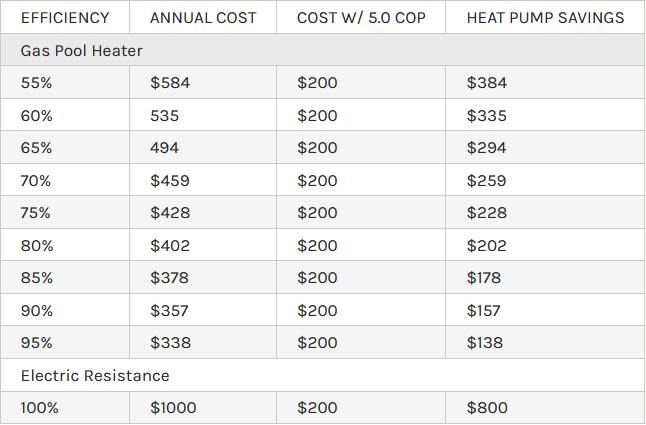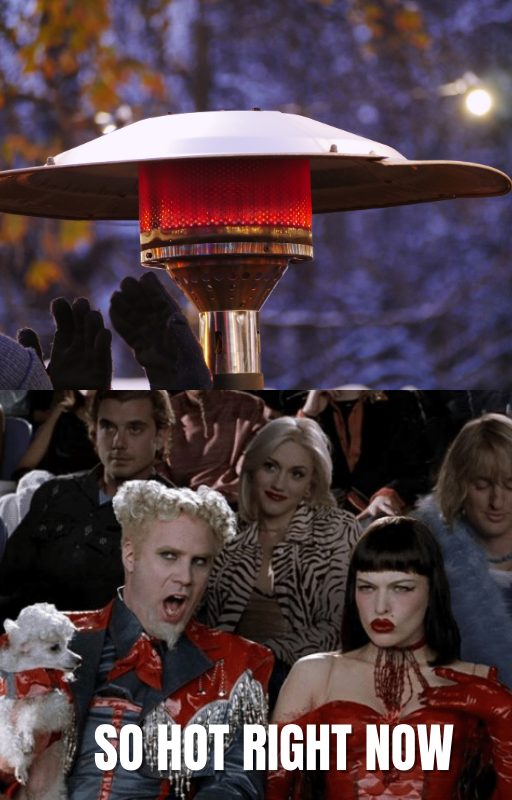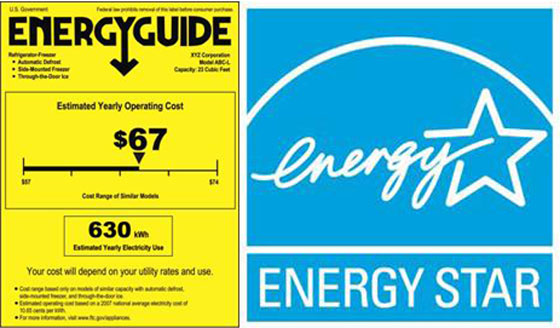November is here and no matter where you live in the US, you’ve got to be concerned with staying warm at home. However, where you live makes a difference in how and what you heat. From heating the pool room in the basement to warming the water in your swimming pool outside, here’s a look at home heating and how you can be more energy-efficient this winter.
Whole House vs Whole Room
The first decision you’ve got to make when evaluating the most energy-efficient way to heat your home is how much of the home you need heated.
If you live in Kendall, Wisconsin, the average January high is 26°F and winter looks like this:

But if you live in Kendall, Florida, the average January high is 76°F, and winter is a bit more like this:
These two cities might share the same name, but their residents’ needs when it comes to keeping warm in the cold seasons are very different.
Kendall, Wisconsin residents need to heat the entire home. It’s necessary for the comfort of the people inside, as well as for the safety of the home’s plumbing and electrical systems. But Kendall, Florida residents just heat a bathroom or a bedroom on the few days that any heat at all is needed.
So, we’ll break down heating methods by the whole house and by room:
Energy Efficient Heating: For the Whole House
With whole-house heating, you have a centralized heating unit and a method of distributing the heat. The heat can be distributed via ductwork that circulates warm air by using a fan and blower motor. Or you could have pipes and radiators that move steam or boiling water with pressure. Modern homes most often use a furnace or a heat pump. Older homes still typically rely on steam and boilers.
Whole House Furnace
If you live in a very cold climate, the most common method of heating is a furnace. The furnace is fueled by gas or electricity. Air is warmed at a central unit to the temperature specified by the thermostat, then it is moved throughout the house via ductwork and fed into the individual rooms via supply registers. In parts of the country where heat is more important than air conditioning, the supply registers are on the floors. Where air conditioning is more important than heat, the registers are in the ceiling or in soffits at the top of the walls. The heated air leaving the floor level vents rises and warms the room. As the air cools, it falls and is drawn into a return register that sends the cool air through the ductwork back to the furnace to warm the air again.
Important Reminder:
We interrupt this article for a scientific reminder about the nature of warm and cool air.
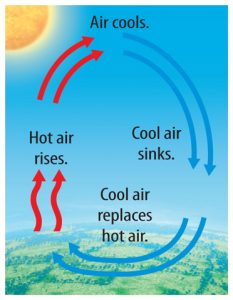
Warm air rises and cool air falls. As the air gets warmer, the molecules get all excited and zip around quickly. This spreads the molecules out over a larger space, making the air less dense. Because it is less dense, the air rises. Cool air molecules are slug bugs; they move slowly and huddle together. This makes cool air more denser. Because it is dense, it falls.
We now return you to the discussion of forced air heating:
Gas, oil, or electric?
Your furnace heats through the burning of natural gas, heating oil, or electricity.
Natural gas furnaces draw air in from outside and mix it with return air from inside. The heating process happens via combustion in the heat exchanger. Next, warm air enters the ductwork and the carbon monoxide (produced during combustion) leaves the house through a flue to an outside vent.
Natural gas is abundant and burns clean. A natural gas furnace will cost more than an electric furnace or an oil-burning furnace upfront but will save on operating costs. It is an efficient way to heat, with an 83.9% combustion efficiency rate. Natural gas is a fossil fuel, but it burns cleaner than other fossil fuels and produces fewer greenhouse emissions.
Oil burning furnaces work in a similar fashion to natural gas furnaces. Both rely on the combustion that occurs within a heat exchanger. However, an oil burner stores its fuel in a holding tank. Fuel flows from the tank to the combustion chamber, where it is atomized. Next, an electronic ignition lights the atomized oil, and it burns.
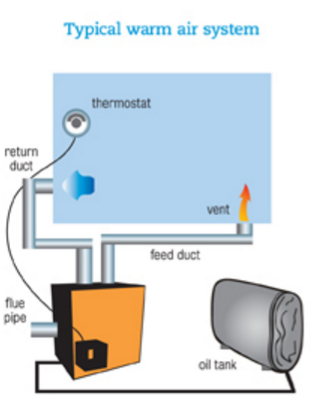
The heated air then enters the ductwork and circulates in the same manner as the air heated by a natural gas furnace. Using an oil-burning furnace tends to cost less than using a natural gas furnace when it comes to heating a home. However, the former will cost you more to maintain, as the fuel filters need to be changed regularly and the nozzles must be kept clean.
If you are in an area of the country such as the Northeastern states where natural gas is not available, oil furnaces are an option to consider. You can use a two-stage burner to increase energy efficiency and lengthen the life of the furnace.
Also, some modern oil-burning furnaces can operate off a blend of traditional heating oil and biodiesel to burn cleaner and reduce the environmental impact of the heating fuel. Depending on the age of your furnace, the combustion efficiency can range from 80% to up to 90% for units with a two-stage burner.
Electric furnaces don’t burn fuel to create heat. They instead create heat via special coils. These tightly-wound metal coils sit in stacks inside the furnace. When the thermostat says it’s time to get to work, a sequencer begins to heat the coils.
Not all coils heat at once, if they did the power draw would trip the breaker or blow the fuse. Instead, they heat slowly and when they reach the desired temperature, the blower motor kicks on and moves the warm air through the ductwork to registers in each room.
On the plus side, electric furnaces heat with 100% fuel efficiency, as all fuel is consumed in the heating process and none is exhausted. On the minus side, according to the DOE, this is the most inefficient way to heat a home. This is because much of the heat generated is lost in the ductwork before the air makes it to the room.
If you live in Kendall, Florida, or any place where the climate is mainly warm, an electric furnace is an option worth considering. They create zero emissions, are inexpensive to purchase, and because no combustion is involved, they don’t require as much maintenance.
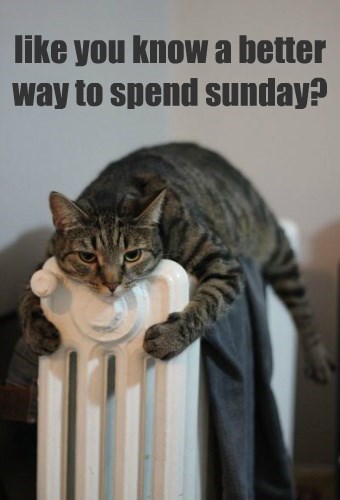
Whole House Boiler
There’s more to whole-house heating than the standard furnace. Some older homes and multi-family homes use steam or boiled water to heat.
A central boiler is powered by natural gas or heating oil. Just as boiling water for spaghetti creates steam, these large boiler furnaces produce steam and then use pipes to push the steam through baseboards or radiators. The water condenses as it cools and the pipes return the water to the boiler to be heated again.
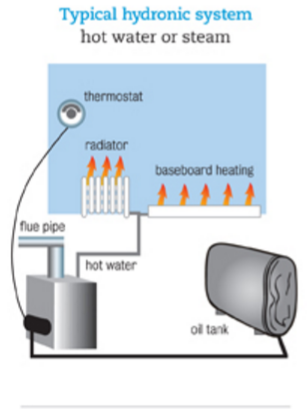
Water-powered or hydronic systems don’t move air at all. They won’t ever blow dust around the way a forced air furnace will, and there are no registers or air filters to clean. Because they have few moving parts, there are fewer parts to break down. However, they do require annual inspection and routine maintenance because they do pose a safety hazard.
Boiler systems deliver uneven heating with some rooms warmer than others and sometimes, portions of individual rooms may not be evenly heated. Like furnaces, boilers must consume fuel to heat the water. Heating oil and natural gas are the most common fuels, and the combustion efficiencies remain the same. However, when determining true energy efficiency, you’ve got to consider the amount of heat loss in delivery.
Whole House Heat Pump
If you live in a coastal area, one of the southern states, or anywhere the average winter temperature stays in the 40°F to 50°F range, the most efficient whole house heater is a heat pump. Unlike furnaces and steam systems that create heat, heat pumps move heat around. A heat pump is an air conditioning unit that works in reverse. So, you can cool with a heat pump and heat with a heat pump. Sound too good to be true?
Hold your horses! All heat pumps are air conditioners, but not all air conditioners are heat pumps. Just because you have a central A/C unit in your house right now doesn’t necessarily mean it is a heat pump. However, if it has the ability to run in reverse, it probably is.
A heat pump takes heat from the air outside your house and transfers it to the refrigerant which compresses the warm air and, in the process, heats the coolant considerably. Then it moves the warm coolant (sounds strange, right?) to the inside unit where it passes air over the hot coolant. That warm air is what warms the house.
This method like a charm as long as it’s not too cold outside. It’s the most energy-efficient way to heat if your climate isn’t frigid. If it is, there’s just not enough warmth in the air outside for the process to work very well.
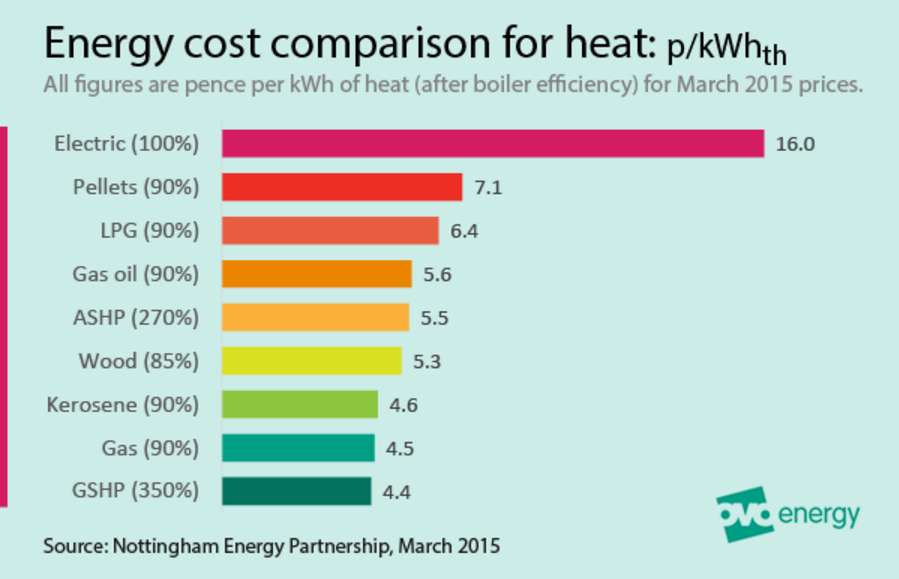
The process we’ve described is for an air source heat pump. These operate off electricity only. There are other forms of heat pumps, such as the absorption heat pump. They work in a similar manner, but instead of condensing refrigerant, they use ammonia and water. They are run off natural gas or geothermally heated water.
Geothermal heat pumps extract heat from below the Earth’s surface. According to the US Department of Energy, they cost several times more to purchase and install but have the lowest operating cost, and the portion above the ground lasts more than 20 years while the portion underground is good for more than 50 years.
Energy Efficient Heating: For Individual Rooms
Maybe you live in a mild climate and it rarely gets cold. Or let’s say you want to turn down the thermostat in the whole house and just heat the room you use. What about if you live in Bismarck, North Dakota, and made the mistake of installing a heat pump and the house is chilly?
For any of those maybes, a portable room heater can be the answer to knocking the chill out of a small area. There are plenty of options depending on whether you want to warm the people or warm the air.
Convection heaters
These heaters use the same principle that creates beautiful pastries in the oven to warm the air in a room. A fan pulls cold air across a heating source to warm it. Then the fan kicks the air back into the room. The heater constantly circulates and warms the air in the room.
Unfortunately, these fan heaters can be loud. Here someone tried to turn the fan noise into white noise to help them sleep:
So what if you want something quieter? Or perhaps you have allergies and worry about dust stirred up by the convection heater fan. Conduction convection heaters are an option. Electricity flows through a resistor that converts the energy to heat. Remember the old ‘warm air rises and cool air falls’ reminder earlier in this article? Same principle here. The warmed air naturally rises and circulates without the use of a fan.
Radiant heaters
Radiant heaters direct heat to a specific area. They aim to warm people, not the air around the people. Electricity heats stone, ceramic, or metal and then a reflector directs the heat where you want it. It doesn’t warm a room quickly, but it’s just the ticket to warm a person quickly.
Radiant heaters installed under flooring warm an entire room. It’s a popular way to warm a bathroom a bedroom, or a living area. By heating the room from the ground up, homeowners with radiant heat experience a warm feeling underfoot with little to no cold spots. Additionally, because they don’t need to run as hot as a furnace or convection heater, they use less energy.
You can install most flooring over radiant heat. There’s a misconception that you can’t install hardwood over radiant heat. But if the manufacturer approves and you follow these tricks for installing bamboo floors over radiant heat, you’ll have floors that look and feel warm.
Infrared heaters
Ever stood with the sun warming your face on a chilly Spring day? Just the sunlight on your face seems to warm you all over.
That’s because the sun kicks out a serious amount of infrared light. When your skin absorbs infrared light, it makes you feel warm. Portable infrared heaters are like operating your own sun, minus all that pesky nuclear fusion.
They heat immediately because they emit light as soon as you turn them on. There’s no need for a fan to scatter the light, so they are quiet. They are efficient in that they don’t heat the air and they don’t burn fossil fuels; they just heat the people and objects in the room. On the downside, you must be in the line of sight of the light to be warmed.
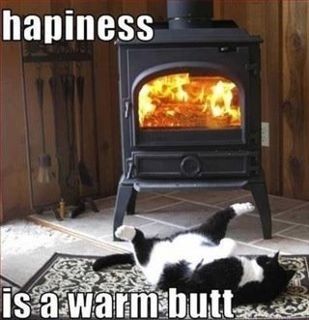
Wood pellet stoves
Wood pellet stoves can be used to heat an entire small house but are more commonly used to heat small areas – and cats, apparently! Unlike electric or natural gas heating, they run off a renewable resource – wood. However, modern pellet stoves do use a small amount of electricity.
While pellets burn cleanly, you still lose some heat out of the chimney and you still do create some air pollution. But the amount of pollution is much less than a traditional wood-burning stove. This method of heating is energy efficient on the part of the heater, but you’ll be using a bit of your own energy to haul the 40-pound bags of pellets and the ashes.
Ways to Heat the Pool and Spa
In some parts of the country, it may get cold, but people still enjoy relaxing in the water. In these areas, homeowners opt to keep the pool and spa running all year long. However, the water must be kept warm somehow. Otherwise, every dip in the pool or soak in the spa will be equivalent to the Polar Bear Plunge. Here are the best ways to keep that water warm.
Heat pumps
Remember this guy from whole house heating? Turns out he is one popular dude when it comes to heating pools and spas, too! The US Department of Energy recognizes the heat pump as the most energy-efficient way to heat the water in your pool or spa. But they are only effective where the temperature doesn’t dip lower than 50°F.
Gas heaters
Gas heaters use about 70% more energy than a heat pump and can maintain any water temperature. They work in even the coldest climates. They cost less upfront but cost more to operate than a heat pump. Because they have more moving parts, they require more maintenance. A gas heater will heat the pool or spa faster than a heat pump and can be used no matter how cold it is outside.
This Rochester, New York family doesn’t let a little snow get in the way of enjoying their water play, so why should you? A gas heater warms the water in this cold climate where a heat pump just isn’t able to get the job done.
Electric heaters
If natural gas isn’t available and zoning prohibits propane storage, then your final option for heating the pool or spa is an electric heater.
This is the most expensive and least efficient way to heat the water. Now it’s true that using electricity to generate heat is 100% efficient in that no heat is lost to exhaust or transmission, but it takes a long time to heat a pool with an electric heater. So, the heater runs longer and uses more power.
This chart created by the Department of Energy compares the cost of pool heating with each method:
Pool and spa covers
If you’re going to use energy of any sort to heat the water, you should make the most of the energy you use. Keep a cover on your pool or spa when not in use to keep the water warm.
A cover will trap the heat as it rises off the water and redirects it down back to the water. You retain the heat you’ve already created and your heater or heat pump won’t have to work so hard to maintain water temperature.
Heating the Patio and Outdoor Living Spaces
Finally, with more and more people opting to spend time outdoors due to the current pandemic, patio heaters are quite literally a hot commodity this season.
Restaurants have been using patio heaters for years to keep diners warm while dining al fresco in the fall and spring. These commercial grade heaters are also available in a smaller form for home use.
Fuel Sources
You’ll find patio heaters that operate on natural gas, propane, electricity, and even good old wood.
Chimeneas and firepits are technically wood-powered patio heaters. They do create sparks and embers and aren’t the safest option for use around children or pets. However, wood is a renewable resource even if it isn’t the most efficient way to heat an area.
Natural gas patio heaters are attached to an existing gas line and need to be professionally installed. They aren’t portable but they are an energy-efficient way to heat your outdoor living areas. These patio heaters fire up quickly and require a well-ventilated area. That’s not generally a problem on an open patio.
Propane patio heaters are attached to propane tanks (think of your typical gas patio grill) and are highly portable. Like natural gas, they heat up quickly. They are energy efficient, but propane often costs more than natural gas. On the other hand, propane heaters don’t require professional installation and cost less upfront.
Electric patio heaters can create radiant heat or infrared heat. They are usually small in size, so they only work in small, enclosed spaces. Additionally, electricity is more expensive than natural gas or propane, so they have a higher operating cost. You can use this handy calculator to figure out how much it will cost to operate your portable electric heater.
Look for the Star
No matter how you decide to heat your home this winter, look for Energy Star-rated appliances, rebates, and associated tax credits.
The Energy Star program promotes energy efficiency and helps shoppers make the most informed decisions.
When a product carries the Energy Star label, this means that it meets strict standards for energy efficiency set by the EPA. Local fuel suppliers like gas companies and electric operators offer rebates on certain appliances that carry this label. So, start your search at EnergyStar.gov to save energy, save money, and save the environment.

About the Author
Cheryl is our go-to guru for all things sustainable living. She’s on a mission to make your family and our planet thrive! With a heart as big as her passion for sustainability, Cheryl brings you the freshest insights on eco-friendly building products and energy efficiency. 🌱💡
And hey, did you hear about the eco-friendly lightbulb that went to therapy? It finally found its inner “enlightenment”! 😄 Join Cheryl on this green journey, where she’ll tackle your concerns with a smile and a sprinkle of eco-humor!



